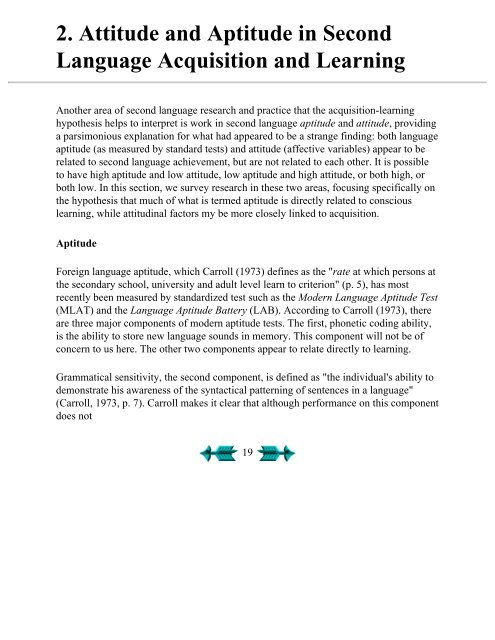Second Language Acquisition and Second ... - Stephen Krashen
Second Language Acquisition and Second ... - Stephen Krashen
Second Language Acquisition and Second ... - Stephen Krashen
You also want an ePaper? Increase the reach of your titles
YUMPU automatically turns print PDFs into web optimized ePapers that Google loves.
2. Attitude <strong>and</strong> Aptitude in <strong>Second</strong><br />
<strong>Language</strong> <strong>Acquisition</strong> <strong>and</strong> Learning<br />
Another area of second language research <strong>and</strong> practice that the acquisition-learning<br />
hypothesis helps to interpret is work in second language aptitude <strong>and</strong> attitude, providing<br />
a parsimonious explanation for what had appeared to be a strange finding: both language<br />
aptitude (as measured by st<strong>and</strong>ard tests) <strong>and</strong> attitude (affective variables) appear to be<br />
related to second language achievement, but are not related to each other. It is possible<br />
to have high aptitude <strong>and</strong> low attitude, low aptitude <strong>and</strong> high attitude, or both high, or<br />
both low. In this section, we survey research in these two areas, focusing specifically on<br />
the hypothesis that much of what is termed aptitude is directly related to conscious<br />
learning, while attitudinal factors my be more closely linked to acquisition.<br />
Aptitude<br />
Foreign language aptitude, which Carroll (1973) defines as the "rate at which persons at<br />
the secondary school, university <strong>and</strong> adult level learn to criterion" (p. 5), has most<br />
recently been measured by st<strong>and</strong>ardized test such as the Modern <strong>Language</strong> Aptitude Test<br />
(MLAT) <strong>and</strong> the <strong>Language</strong> Aptitude Battery (LAB). According to Carroll (1973), there<br />
are three major components of modern aptitude tests. The first, phonetic coding ability,<br />
is the ability to store new language sounds in memory. This component will not be of<br />
concern to us here. The other two components appear to relate directly to learning.<br />
Grammatical sensitivity, the second component, is defined as "the individual's ability to<br />
demonstrate his awareness of the syntactical patterning of sentences in a language"<br />
(Carroll, 1973, p. 7). Carroll makes it clear that although performance on this component<br />
does not<br />
19











